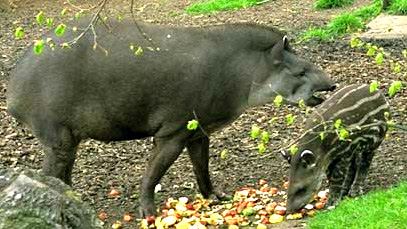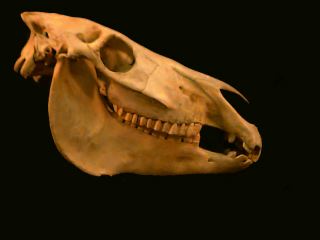
ORDER PERISSODACTYLATwo living suborders: Ceratomorpha: tapirs and rhinoceroses. Hippomorpha: horses, palæotheresÝ & titanotheresÝ There is also a third, now extinct, suborder- Ancyclopoda: chalicotheresÝ. (Ý denotes an extinct group). Perissodactyls are characterised chiefly by:
They were once a very widespread and diverse group, but have been on the wane since the late Miocene as the artiodactyls have prospered.
SUBORDER CERATOMORPHA. This suborder was very successful in the Eocene and Oligocene, when there were several different families of rhinoceroses and tapirs. Today there are only two families. FAMILY TAPIRIDAE: THE TAPIRS.
All four living tapirs belong to the genus Tapirus, an ancient taxon present in the northern hemisphere at least 20MY ago. The primitive features of the tapir demonstrate its antiquity. Digit reduction has only taken place on the hind feet - despite being mesaxonic the forefoot still has four toes. The legs are short and the body is heavy with a curved back. Compare the body shape with that of the peccary (Order Artiodactyla, Family Tayassuidae). Both have converged on a similar body shape as a result of their sharing a similar lifestyle and habitat. Today, tapirs are found only in South East Asia (the Malaysian peninsula and the island of Sumatra) and in parts of South and and Central America. The remaining range of this genus is a relict of a distribution that once encompassed the northern continents. The Tapiridae as a whole were once very diverse. In the early Tertiary a variety of forms evolved in Asia before being superseded by the artiodactyls. These included horse-like and rabbit-sized tapirs.
Tapirs are usually found in forested habitats and rarely far from water. Their diet includes fruit, leaves, buds and grass, collected by their prehensile proboscis. The tapir's teeth are also specialised - most of the pre-molars are molarised, and the molars are quite high-crowned with crests. A diastema is present. The presence of the nasal bones midway up the face indicates the presence of a proboscis. This allows the evolution of the proboscis in extinct tapirs to be traced. The striking colouration of the Malayan tapir and the coarse manes of the Amazonian and Baird's tapir are anti-predator adaptations. Tapirs are hunted for their skins, their meat and for sport. However, undoubtedly the biggest threat to their future is the destruction of their habitats.
FAMILY RHINOCEROTIDAE : THE RHINOCEROSES.
There are 5 types of living rhinoceroses - 2 in Africa and 3 in south Asia. All are currently at risk of immediate extinction except perhaps the white rhino which is protected in South Africa. Rhinoceroses have been hunted for centuries for the supposed medicinal effects of the horn (pharmacologically unproven) and to make horn-handled daggers in the Yemen. The plight of the rhino is not helped by their solitary lifestyle. Indian rhinoceroses of both sexes live in a home range containing all necessary resources and are hostile to other members of the same sex.
The skull of the Indian rhinoceros shows high crowned, crested molars associated with a browsing/grazing habit. The Indian rhino eats mostly short grass, also browses with its prehensile lip. Unlike African rhinoceroses, incisors are present. Only Sumatran rhinoceroses have canines. Heavily built, the skull would carry a large horn made of keratin, not bone, attached to a roughened area on the skull.
Rhinoceros limbs are mesaxonic, like all perissodactyls, and show little reduction in the number of digits - adapted as they are more for supporting the rhinoceros' huge weight rather than making it fleet of foot. Despite this, African white rhinoceroses have an impressive turn of speed.
The earliest rhinoceros, Hyrachyus, was similar the first horse and probably did not look too different to the hyrax of today. Extinct rhinoceroses include Indricotherium, the largest land mammal ever, but rhinoceroses similar to today's probably appeared in the Miocene epoch. SUBORDER HIPPOMORPHA. There were once three families in this suborder, of which only the equids (horses) have survived. The other two died out over 30 million years ago. Equids: The earliest horse, Hyracotherium, was remarkably similar to the earliest rhinoceroses and titanotheres. The earliest perissodactyl cannot have been much different. The evolutionary history of the horses is very well understood. A clear lineage can be traced through the fossil record from Hyracotherium to the modern horse, Equus. There were many 'side-branches' to this lineage of other grazing and browsing horses. Titanotheres: an Eocene/early Oligocene group of huge rhinoceros-like beasts, were driven to extinction by the rhinoceroses themselves who possessed less primitive teeth and were better able to adapt to a grazing habit. Unlike the rhinoceroses, the titanotheres had horns made of bone covered in skin. Palæotheres: most closely related to the horses, this predominantly European group of perissodactyls may well have evolved from Hyracotherium. In the absence of tapirs the palæotheres became medium-sized, robust browsers. Parallel evolution even led to the evolution of a short proboscis similar to that found in Tapirus. FAMILY EQUIDAE
There are seven members currently found in this family, all genus Equus : the domestic horse, wild horse, 3 zebras and two asses.
The family is typified by large, long heads on long necks and slender legs. Horses are very much a product of the grasslands. Their dentition copes with the silica found in grasses and their unguligrade limbs allow swift travel across the plains. As hindgut fermenters, horses can live on poorer forage than ruminants. The higher throughput rate allows more to be taken. However, large quantities must be eaten - about 16 hours a day are spent foraging. Except for the plains zebra all the wild horses are rare. Preszwalski's horse is found only in zoos, and is vulnerable to genetic dilution as a result of interbreeding with domestic horses.
All members of the genus have similar skulls - a deep lower jaw; upper and lower incisors; a long diastema; high crowned, ridged pre-molars and molars; eyes far back in the skull providing binocular vision and a wide field of view.
SUBORDER ANCYCLOPODA. Two families: the advanced Chalicotheriidae and the more primitive Eomoropidae (the latter intermediate between the chalicotheres and the most primitve perissodactyls). Chalicotheres: an unusual family of ungulates with claws instead of hooves. They had primitive teeth, but were horse-like aside from their elongated front limbs. Although never very abundant, these strange animals were fairly successful. Prior to their extinction barely 12,000 years ago the chalicotheres had been relatively unchanged for the previous 25 million years. The claws are often thought to indicate a diet of roots and underground plant parts, but there is no evidence that the feet were used for digging. The fairly long neck of the chalicotheres and their long fore arms to help raise the head and shoulders suggest that they were browsers. |

















